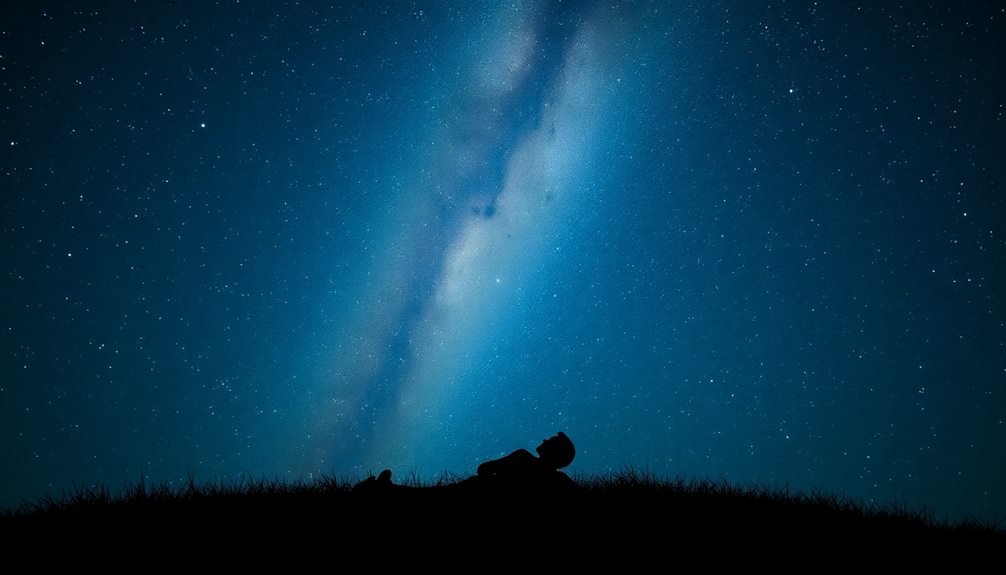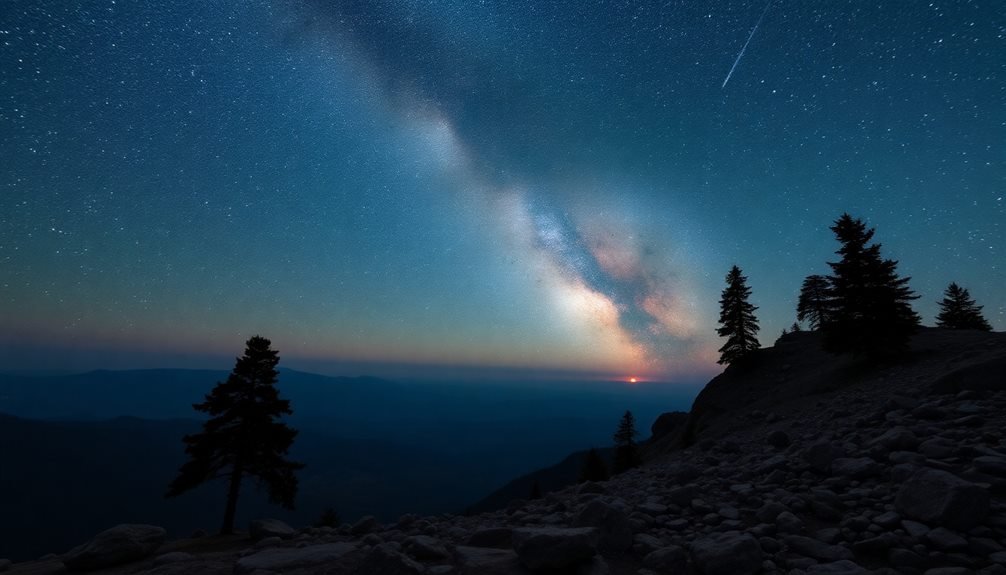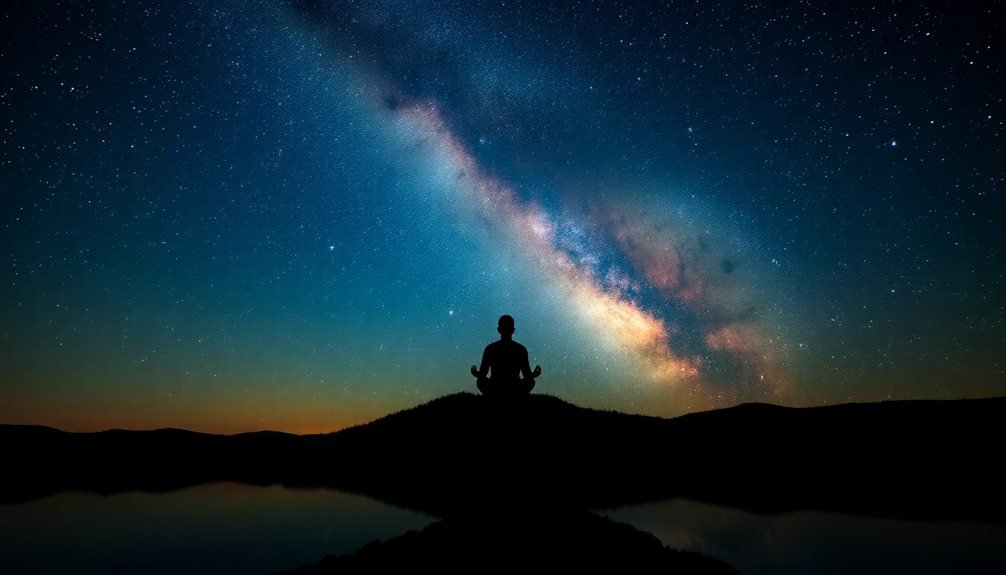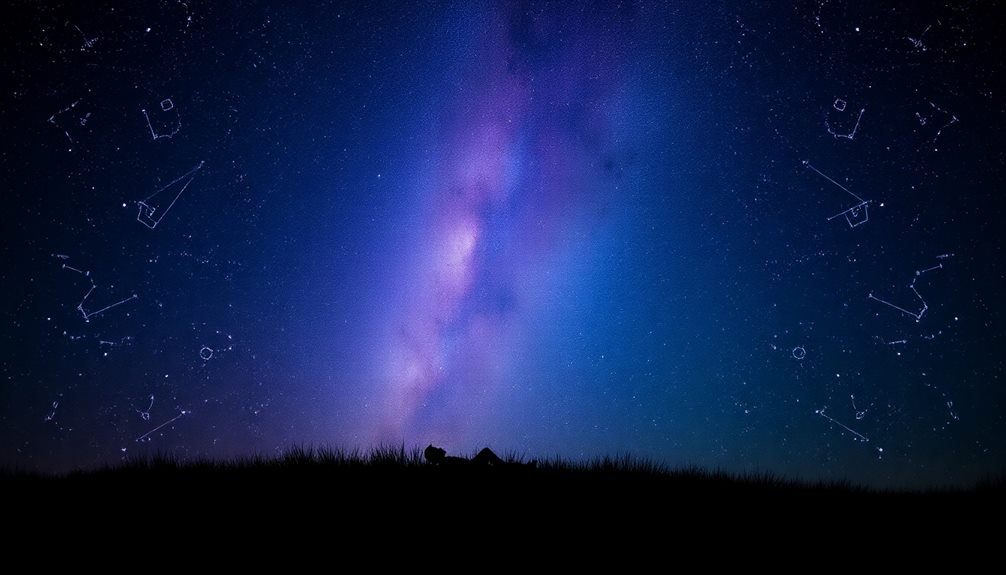Stargazing offers a natural pathway to inner peace by activating your brain's relaxation response and shifting focus away from daily stresses. You'll find that darkness triggers melatonin production, helping regulate sleep and reduce anxiety while the predictable patterns of stars provide a sense of stability. To begin, you'll need basic equipment like a red flashlight, binoculars, and a star chart, along with comfortable gear for extended viewing. Choose locations away from light pollution, preferably at higher elevations with clear skies. When combined with mindful breathing techniques and regular practice, stargazing becomes a powerful tool for achieving tranquility. The cosmos holds countless secrets to help guide your journey toward serenity.
Why Stars Calm Our Minds

Gazing at the stars triggers a profound sense of peace in our brains, activating regions linked to relaxation and wonder. When you look up at the night sky, your mind naturally shifts away from daily stressors and enters a meditative state.
This astronomical therapy works because stargazing forces you to slow down, breathe deeply, and focus on something vastly larger than yourself.
The darkness required for stargazing helps too. Your brain produces melatonin in response to darkness, which regulates your sleep-wake cycle and reduces anxiety. As you observe the stars, your pupils dilate fully, allowing your eyes to capture more light and your mind to become fully engaged in the experience.
There's also a psychological component at play. You're connecting to the same celestial view that humans have marveled at for millennia.
This perspective helps you recognize that your current worries are temporary against the backdrop of cosmic time. The predictable patterns of star movement and constellations provide a sense of order and stability, while the infinite expanse reminds you that there's more to existence than your immediate concerns.
Essential Equipment for Night Watching
You'll need a few basic tools to begin your stargazing journey, including a red flashlight to preserve your night vision, a comfortable reclining chair or blanket, and a simple star chart or astronomy app.
For more serious sky watching, consider investing in a quality pair of binoculars, which can reveal stunning details of the Moon, star clusters, and even some planets.
If you're ready to take your stargazing to the next level, a portable telescope with a steady mount will open up a vast universe of celestial wonders for your exploration.
Basic Stargazing Gear Checklist
Before heading out into the night for stargazing, gathering the right equipment will make your experience both comfortable and rewarding.
You'll need a mix of essential observation tools and comfort items to guarantee you can focus on the celestial wonders above.
Start with these fundamental stargazing tools:
- A red flashlight to preserve your night vision while reading star charts or making adjustments to your equipment
- A pair of 7×50 or 10×50 binoculars, which offer an ideal balance of magnification and field of view for beginner stargazers
- A detailed star chart or astronomy app on your mobile device to help identify celestial objects
Don't forget your comfort gear: a reclining chair or blanket for extended viewing sessions, warm layers of clothing (even summer nights can get chilly), and insect repellent during warmer months.
You'll also want to pack water and snacks, as stargazing often involves waiting for your eyes to adjust or for specific celestial events.
Consider bringing a notepad to record your observations and a compass to help with celestial navigation.
If you're using a smartphone app, remember to enable night mode to protect your dark-adapted vision.
Specialized Equipment Worth Investing
The right specialized equipment can dramatically enhance your stargazing experience once you've mastered the basics. A quality telescope serves as your primary investment, with computerized GoTo mounts offering precise object tracking.
You'll want to take into account either a reflector telescope for deep-sky viewing or a refractor for planetary observation, depending on your interests.
A quality eyepiece collection is essential, featuring various focal lengths from 32mm to 6mm. You'll need filters too – light pollution filters help in urban areas, while planetary filters enhance detail on Mars, Jupiter, and Saturn.
Don't forget a sturdy equatorial mount for smooth tracking of celestial objects across the night sky.
For astrophotography enthusiasts, a DSLR camera adapter and tracking mount are must-haves. Think about investing in specialized software for astronomy planning and celestial navigation.
A red-light headlamp keeps your hands free while preserving night vision, and a portable power station guarantees your electronic equipment runs throughout your session.
Best Locations for Celestial Viewing

Selecting an ideal stargazing location can make the difference between a mediocre and magnificent celestial experience. You'll want to find spots far from city lights, where light pollution won't interfere with your view of the cosmos. Dark sky preserves and national parks often provide the perfect backdrop for your astronomical adventures.
When choosing your viewing location, consider these essential factors:
- Elevation matters – higher altitudes mean you're above much of Earth's atmosphere, resulting in clearer views of stars, planets, and deep-sky objects.
- Weather conditions – seek areas known for clear skies and low humidity, as clouds and moisture can greatly impact visibility.
- Accessibility and safety – verify you can safely reach and leave your chosen spot, even in darkness, and that it's a permitted area for nighttime activities.
Mountain peaks, desert regions, and coastal areas away from urban centers typically offer prime viewing conditions.
You'll find that timing your visit during a new moon phase will further enhance your experience, as moonlight can wash out fainter celestial objects.
Don't forget to check local weather forecasts and astronomical calendars to plan your stargazing session during ideal viewing conditions.
Breathing Techniques Under Stars
When you're gazing at the stars, you'll find deeper relaxation by matching your breath to their twinkling rhythm – inhaling as a star brightens and exhaling as it dims.
Let your breathing become naturally slower while you make a mindful connection with the vast celestial expanse above you.
You can enhance this cosmic meditation by choosing one particularly bright star as your focal point, allowing its steady presence to guide your breathing pattern.
Sync Breath With Stars
Breathing mindfully under a starlit sky creates a profound connection between your body's natural rhythm and the cosmos above. As you gaze upward, let your breath synchronize with the twinkling stars, establishing a meditative cadence that calms your mind and steadies your heart rate.
Choose a bright star or constellation as your focal point, and match your breathing pattern to its perceived pulsation. You'll find that this cosmic breathing technique helps dissolve daily stress while heightening your awareness of the vast universe surrounding you.
To effectively sync your breath with the stars, follow these essential steps:
- Inhale slowly for four counts while watching your chosen star brighten
- Hold your breath for two counts as the star's light appears to stabilize
- Exhale gradually for four counts as the star seems to dim
This rhythmic breathing pattern mirrors the natural ebb and flow of stellar light, creating a deeply personal connection with the celestial world.
As you continue this practice, you'll notice your breathing becomes more regulated and your mind more centered, allowing you to experience a unique form of astronomical meditation.
Mindful Sky Connection
Regularly establishing a mindful connection with the night sky demands more than casual stargazing – it requires specific breathing techniques that ground you in the present moment. As you lie beneath the stars, focus on taking deep, measured breaths while maintaining awareness of the vast cosmos above you.
Start with the 4-7-8 celestial breathing technique: inhale for four seconds while focusing on a specific star, hold your breath for seven seconds as you observe its brightness, then exhale slowly for eight seconds as you imagine your stress dissolving into the night air.
You'll find this rhythm naturally aligns with the sky's peaceful energy.
When you spot a constellation, try constellation breathing: trace its shape with your eyes while taking continuous, steady breaths. Each point of light becomes a pause in your breath, creating a natural pattern that connects you to the ancient patterns above.
These breathing exercises help you develop a deeper appreciation for the night sky while reducing anxiety and mental chatter.
You're not just observing the stars; you're becoming part of the cosmic rhythm through your conscious breathing.
Connecting With Cosmic Rhythms

Deep observation of celestial patterns naturally aligns your internal rhythms with the cosmos. As you track the moon's phases and planetary movements, you'll notice your awareness shifting to match these celestial cycles.
You'll find yourself more attuned to nature's timing and better equipped to flow with life's natural ebbs and flows. Your connection with cosmic rhythms strengthens as you establish a regular stargazing practice.
Watch how the stars wheel overhead each night, and you'll start recognizing the sky's predictable dance. This awareness helps you develop a deeper sense of your place in the universe's grand choreography.
To enhance your cosmic rhythm connection:
- Observe the moon's monthly cycle and note how it affects your energy levels and sleep patterns
- Track sunrise and sunset times, allowing your daily routine to sync with natural light rhythms
- Monitor seasonal constellation changes to understand your connection to Earth's annual journey
You're part of an intricate cosmic dance that's been ongoing for billions of years. By consciously connecting with these celestial patterns, you'll discover a natural tempo that brings greater harmony to your daily life.
Making Stargazing Your Nightly Ritual
Simple habits create lasting change, and transforming stargazing into your nightly ritual can become a powerful anchor for inner peace. By dedicating just 15 minutes each evening to observe the night sky, you'll establish a consistent practice that grounds you and offers respite from daily stresses.
Start by selecting a comfortable viewing spot – perhaps a deck chair in your backyard or a cozy window seat. Keep a warm blanket, red-light flashlight, and star chart nearby. Set a specific time each night, ideally an hour after sunset, when the sky darkens enough to reveal its celestial treasures.
You'll find that your eyes naturally adjust to the darkness within 20 minutes.
Don't pressure yourself to identify every constellation immediately. Instead, begin by simply gazing upward and letting your mind settle. Notice how the stars emerge gradually, like thoughts quieting in meditation.
Track the moon's phases and position changes nightly. As you become more familiar with the sky's patterns, you'll start recognizing regular visitors – planets, prominent constellations, and even satellites. This growing familiarity creates a sense of connection and stability that enhances your evening routine.
Frequently Asked Questions
Can Stargazing at Night Affect My Sleep Patterns or Circadian Rhythm?
Yes, nighttime stargazing can disrupt your sleep patterns if you're exposed to artificial lights or screens. However, if you use red lights and limit exposure, you'll maintain your body's natural circadian rhythm.
What Should I Do if Cloudy Weather Persists for Weeks?
You can explore astronomy apps, planetarium visits, or virtual telescope tours during cloudy periods. Don't let bad weather discourage you – use this time to learn constellations and plan future observation sessions.
Are There Any Smartphone Apps That Enhance the Stargazing Experience?
You'll find several excellent apps like Stellarium, Star Walk, and NASA for stargazing. They'll help you identify constellations, track celestial events, and locate planets. Sky Map's even free and works offline.
How Do Different Moon Phases Impact the Visibility of Stars?
During a full moon, you'll see fewer stars due to its bright glare. You'll spot many more stars during a new moon's dark sky. Other moon phases offer varying visibility depending on moonrise timing.
Can Stargazing Help With Anxiety and Depression Symptoms?
Yes, stargazing can ease your anxiety and depression. When you're looking up at the stars, you'll feel calmer, more grounded, and connected to something bigger. It's a natural way to quiet racing thoughts.
In Summary
You'll find that stargazing becomes more than just observing distant lights – it's your personal gateway to tranquility. When you make this cosmic connection part of your nightly routine, you're tapping into something timeless and profound. Let the stars guide your breath, calm your thoughts, and remind you of your place in this vast universe. There's peace in knowing you're part of something so magnificently infinite.





Leave a Reply